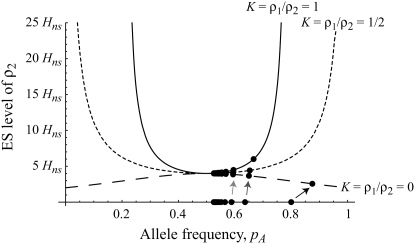Figure 3.—
Evolutionarily stable level of assortative mating in the preference-based model without costs. Assortative mating initially evolves when  , but this process is self-limiting if heterozygotes more readily find mates. Once the strength of sexual selection generated by assortment causes heterozygotes and homozygotes to become equally fit (
, but this process is self-limiting if heterozygotes more readily find mates. Once the strength of sexual selection generated by assortment causes heterozygotes and homozygotes to become equally fit ( ; curves), further increases in the level of assortative mating are no longer favored (Equation 17). Whether or not a stable internal polymorphism exists along these curves depends on the form of frequency-dependent natural selection. The solid circles show stable equilibrium points,
; curves), further increases in the level of assortative mating are no longer favored (Equation 17). Whether or not a stable internal polymorphism exists along these curves depends on the form of frequency-dependent natural selection. The solid circles show stable equilibrium points,  , using a specific model of frequency dependence:
, using a specific model of frequency dependence:  with
with  ,
,  ,
,  ,
,  , and
, and  . Frequency-dependent natural selection becomes weaker as
. Frequency-dependent natural selection becomes weaker as  is reduced from 1 to 0.1 in increments of −0.1 (solid circles from left to right, without assortment along the x-axis or with assortment along the
is reduced from 1 to 0.1 in increments of −0.1 (solid circles from left to right, without assortment along the x-axis or with assortment along the  curves). Assortative mating drives the frequency of allele A away from
curves). Assortative mating drives the frequency of allele A away from  (arrow with light shading,
(arrow with light shading,  ; arrow with dark shading,
; arrow with dark shading,  ; solid arrow,
; solid arrow,  ). A stable internal equilibrium exists along the
). A stable internal equilibrium exists along the  curve only if frequency-dependent natural selection is sufficiently strong (
curve only if frequency-dependent natural selection is sufficiently strong ( when
when  ;
;  when
when  ;
;  when
when  ). Otherwise, the frequency of allele A rises as assortment evolves, until the polymorphism is lost. Note that the y-axis is measured relative to
). Otherwise, the frequency of allele A rises as assortment evolves, until the polymorphism is lost. Note that the y-axis is measured relative to  in the current population.
in the current population.

